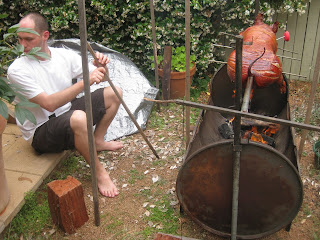Although Mr J is generally the pancake maker in this household (Note to all men: making pancakes every Saturday morning for your lady friend is a good way to both woo her and fatten her up), this morning I decided it was time for me to get my pancake making on and whip up something special for our breakfast... I was also feeling guilty that my having the plague means that Justin can't spend New Years with his friends who, sadly, are all either pregnant or have small kids. The perils of the thirty-something set...
Anyhoo, I digress. Pancakes. Now, ever since my father first introduced me to pancakes in the US when I was a little girl I have eaten these delicious cake-at-breakfast delights at every opportunity that has presented itself. Always I have been torn between the two halves of the pancake world - the light and fluffy buttermilk pancake, and the dark nuttiness of the buckwheat. Deciding between these two is the eternal dilemma for every pancake sitting. But no more! Today I combined the two and I am very please to say it turned out rather well. Possibly next time I will do Mr J's trick of whipping the egg whites separately and then folding them in with the rest of the batter. This produces an extra light and fluffy pancake, but for this morning I settled for the basic product. So, here it is, the best of both worlds.
Buckwheat & Buttermilk Pancakes with Maple Syrup and Nectarines
Ingredients:
- 1/2 cup buckwheat flour (in my case, I apparently bought an organic product too)
- 1/2 cup plain four
- 1/2 cup milk
- 1/2 cup buttermilk
- 1 tsp cinnamon
- 1 tsp baking powder
- 1 tsp vanilla extract
- 1 egg
- 2 tablespoons white sugar
- 1 tablespoon olive oil (or other vegetable oil. Personally, I think peanut oil would add to the nuttiness of the buckwheat)
Throw all the dry ingredients except the cinnamon into a large bowl and whisk together to combine. Then add in the egg, milk and buttermilk and whisk until it looks creamy, but not too much or else it will make it a bit chewy. Then pop in the vanilla extract and the cinnamon and combine. Add in the oil and stir just enough for it to thin out the batter.
Now unleash your biggest frying pan, heat it up on the hob and grease it with butter until it's good and sizzling hot. Using a soup ladle, pour in either one big pancake or two more modest-sized pancakes.
When bubbles are beginning to form it's time to flip them - and don't leave it too late or it will burn. And try to use a nice flat spatula, it's much easier to flip with the right implements. Once they're done, I like to keep them warm on a plate in the oven (about 110 degrees) until they are all ready.
Given the wonderful availability of stone fruit at the moment, I decided to serve these delicious babies with sliced nectarines and pure maple syrup... maple flavoured syrup is the devil's spawn and must be avoided at all costs. I also set the table and we ate like adults. A fabulous distraction from being quarantined for New Year's Eve.
























































